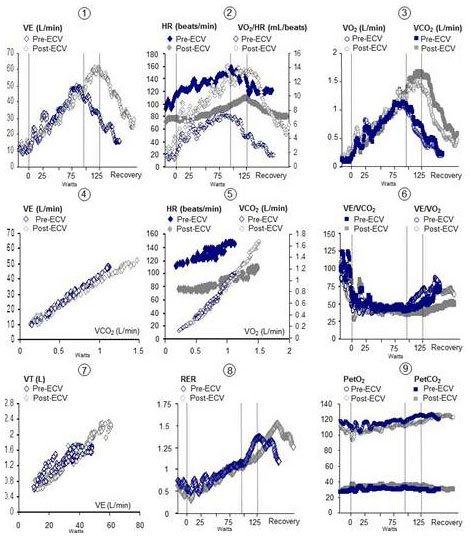The case
Description
This is the cardiopulmonary exercise testing (CPX) graphical (9-plot) report of an hypertensive patient (68 year old) with lone atrial fibrillation. CPX was performed before (blu symbols) and 20 days after external cardioversion (ECV) to sinus rythm (grey symbols).
Before ECV he complained a mixed sensation of dyspnea/fatigue for moderate efforts and occasionally for daily life activities. Symptoms considerably improved post-ECV and the Borg scale (1 to 10) evaluation for effort-induced dyspnea quantification documented a score change from 8 before to 3 after ECV.
Pulmonary function tests (PFT) were performed at pre-ECV examination and documented a normal lung function: Forced Expiratory Capacity: 4,1 L (93% predicted); forced volume in 1 second: 3,9 L (92% predicted). PFT were not repeated after ECV.
The EKG showed a pre-ECV higher heart rate (HR) of 95 beats/min before compared to post ECV, 67 beats/min with excursion to 140 beats/min and 110 beats/min at peak exercise before and after ECV, respectively.
Test Findings
The 9-plot analysis documented 2 major findings to pick up, i.e ECV induced a remarkable improvement in VO2 max (plot # 3), likewise it was observed a significant improvement in VE (plot # 1) yielding to a better VE efficiency as signalled by a lower VE/VCO2 slope after ECV (plot # 4)

Test your knowledge
Interested in learning more?
Access the ESC e-learning platform on prevention, cardiovascular risk factors and sports cardiology .
Not yet an EAPC member?
Note: The views and opinions expressed on this page are those of the author and may not be accepted by others. While every attempt is made to keep the information up to date, there is always going to be a lag in updating information. The reader is encouraged to read this in conjunction with appropriate ESC Guidelines. The material on this page is for educational purposes and is not for use as a definitive management strategy in the care of patients. Quiz material in the site are only examples and do not guarantee outcomes from formal examinations.


 Our mission: To reduce the burden of cardiovascular disease.
Our mission: To reduce the burden of cardiovascular disease.